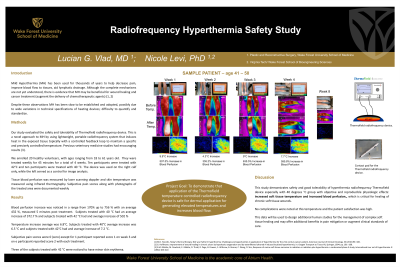Clinical Research
(CR-061) Radiofrequency Hyperthermia Safety Study
Thursday, May 16, 2024
7:30 PM - 8:30 PM East Coast USA Time

Nicole Levi, PhD – Plastic & Reconstructive Surgery – Wake Forest School of Medicine
Introduction: Mild Hyperthermia (MH) has been used for thousands of years to help decrease pain, improve blood flow to tissues, aid lymphatic drainage. Although the complete mechanisms are not yet understood, there is evidence that MH may be beneficial for wound healing and cancer treatment (augment the delivery of chemotherapeutic agents) (1, 2)
Despite these observations MH has been slow to be established and adopted, possibly due to wide variations in technical specifications of heating devices; difficulty to quantify and standardize.
Methods: Our study evaluated the safety and tolerability of thermofield radiofrequency device. This is a novel approach to MH by using lightweight, portable radiofrequency system that induces heat in the exposed tissue topically with a controlled feedback loop to maintain a specific and precisely controlled temperature. Previous veterinary medicine studies had encouraging results (3).
We enrolled 20 healthy volunteers. They were treated weekly for 45 minutes for a total of 4 weeks. Ten participants were treated with 42°C and ten participants were treated with 40 °C.
Tissue blood perfusion was measured by laser scanning doppler and skin temperature was measured using infrared thermography. Subjective pain scores were documented
Results: Blood perfusion increase was noticed in a range from 170% up to 756 % with an average 432 %. Subjects treated with 40 °C had an average increase of 372.7 % and subjects treated with 42 °C had and average increase of 502 %
Temperature increase average was 6.8°C. Subjects treated with 40°C average increase was 6.5 °C and subjects treated with 42°C had and average increase of 7.2 °C.
Subjective pain scores were 0 (zero) except for 1 participant reported score 1 on week 3 and one participant reported score 2 with each treatment.
Three of the subjects treated with 42 °C were noticed to have minor skin erythema.
Discussion: This study demonstrates safety and good tolerability of hyperthermia radiofrequency thermofield device especially with 40 degrees °C group with objective and reproducible physiologic effects: increased soft tissue temperature and increased blood perfusion. This data will be used to design additional human studies addressing different pathologies.
Despite these observations MH has been slow to be established and adopted, possibly due to wide variations in technical specifications of heating devices; difficulty to quantify and standardize.
Methods: Our study evaluated the safety and tolerability of thermofield radiofrequency device. This is a novel approach to MH by using lightweight, portable radiofrequency system that induces heat in the exposed tissue topically with a controlled feedback loop to maintain a specific and precisely controlled temperature. Previous veterinary medicine studies had encouraging results (3).
We enrolled 20 healthy volunteers. They were treated weekly for 45 minutes for a total of 4 weeks. Ten participants were treated with 42°C and ten participants were treated with 40 °C.
Tissue blood perfusion was measured by laser scanning doppler and skin temperature was measured using infrared thermography. Subjective pain scores were documented
Results: Blood perfusion increase was noticed in a range from 170% up to 756 % with an average 432 %. Subjects treated with 40 °C had an average increase of 372.7 % and subjects treated with 42 °C had and average increase of 502 %
Temperature increase average was 6.8°C. Subjects treated with 40°C average increase was 6.5 °C and subjects treated with 42°C had and average increase of 7.2 °C.
Subjective pain scores were 0 (zero) except for 1 participant reported score 1 on week 3 and one participant reported score 2 with each treatment.
Three of the subjects treated with 42 °C were noticed to have minor skin erythema.
Discussion: This study demonstrates safety and good tolerability of hyperthermia radiofrequency thermofield device especially with 40 degrees °C group with objective and reproducible physiologic effects: increased soft tissue temperature and increased blood perfusion. This data will be used to design additional human studies addressing different pathologies.

.jpeg)